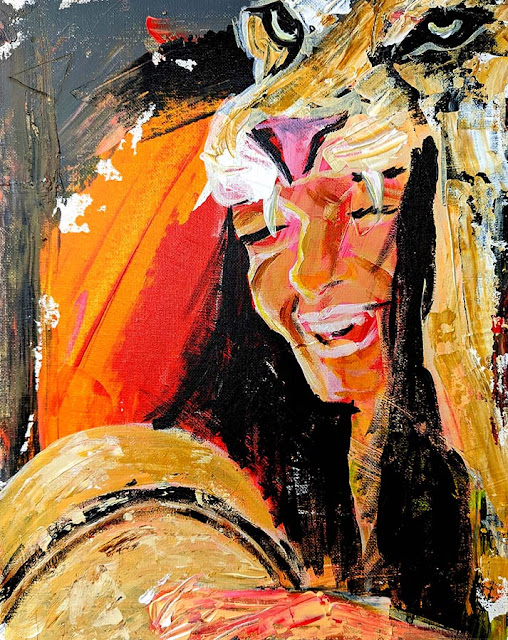Today's painting was inspired by Elisabeth Schmid's reconstruction of the Lowenmensch figurine, a 40,000 year old lion-headed woman carved with stone tools from the tusk of a mammoth. Many have argued that the figurine represents a man. Elisabeth Schmid, a German archaeologist and osteologist, and others, however, argue that this early figurine with its prominent navel and pubic triangle, which are found on early representations of women throughout Old Europe, clearly represents a woman, perhaps the forerunner of the many Goddesses associated with lions throughout history and prehistory.
Lion Woman original painting available through Saatchi Art. Prints, stickers, and other merch available in shop or through RedBubble or Fine Art America.
I have painted my Lion Woman as a shaman with a drum, inspired by Layne Redmond's book When the Drummers Were Women, in which she traces the herstory of spirituality, drumming, and women across the world and also discusses why these traditions were so severely suppressed by later patriarchal religions.
Regarding the Lowenmensch figurine, "The original... is heavily damaged -- and no one knows exactly what it looks like. Many fragments were overlooked in the cave when the prewar dig was so abruptly terminated. Large segments of the surface have broken off" (source).
Plasticine reconstruction of the Lowenmensch figurine by Elisabeth Schmid. (source)
1937 cave excavation during which fragments of the figurine were found. Clearly these men would not have any cultural bias when interpreting the sex of religious objects (laugh emoji).
From a 2017 article in Speigel magazine,
"The statue was found near traces of a fire site in a niche 27 meters (89 feet) from the mouth of the cave. When Kind was working at the site, he also found a decorated deer's tooth, the incisors of an arctic fox and ivory beads. The items could have been pieces from a decorative robe. Perhaps the niche served as a shaman's changing room.
"It is considered likely that prehistoric sorcerers wore furs as costumes when they celebrated rituals around the campfire. Hybrid creatures -- half-man, half-beast -- also appear in cave drawings in France.
"It would seem that the shamans' preferred costumes were the hides of the more dangerous representatives of Ice Age fauna. The cave lion weighed more than 250 kilograms (550 lbs.); one swipe of its giant paw would have been enough. A human being holding what looks like a musical instrument is depicted in a cave in the foothills of the Pyrenees. The figure is wearing the hide of a bison, an 800-kilogram colossus that was not to be trifled with. Perhaps hunters hoped to acquire the animal's strength and even take possession of its soul through masquerade and dance.
"Studies about primitive peoples in Siberia suggest how these rites might have proceeded. Even into the modern age, their shamans wore antlers on their heads. [For instance, this shaman's dress and headdress, which belonged tot he elder daughter of the ex-chief of the Numinchen of Mongolia, in 1932.]
Photo from the Zanabazar Museum of Fine Arts, Ulan Bator, Mongolia (source). This costume is also shown in Layne Redmond's When the Drummers Were Women, on display with accompanying shaman's drum.
"There are similar accounts involving the Blackfeet Indians in North America. Their healers hopped around under bearskins to the sound of drums.
'The Lion Man [Woman] is standing on tiptoes. He [She], too, seems to be dancing.
"But who is hidden underneath the robe? From time immemorial, the lion has been viewed as a symbol of the masculine virtues of courage and strength. [This is incorrect. See Cybele, Sekhmet, Inanna, Ishtar, Tanit, Durga, the Goddess of Catal Hoyuk, etc.]. Shamans still exist today in the Amazon region and Australia. Most are men. [On the contrary, there is much evidence that historically, shamans were women. Many examples exist.]
Female shaman from Indonesia. (source)
The Speigel article continues, "On the other hand, the statuette has some perplexing features. The navel, a symbol of childbirth, is especially pronounced. A horizontal crease runs across the lower abdomen, a feature that is typically female.
"Paleontologist [archaeologist and osteologist] Schmid believes that the figure once had breasts, which eventually broke off. According to Schmid, the transition from the thighs to the buttocks is also indicative of a female body. She made a model out of modeling clay, which is now in a safe in Ulm. It depicts the Lion Man with an ample bosom.
"Many scholars dismissed the jarring replica as nonsense at the time. Nevertheless, there is at least one piece of evidence to support Schmid's theory. An image of a 14,000-year-old human body with an animal head discovered in the Las Caldas cave in Spain is obviously female. The head looks like that of an ibex, while the lower part of the body features female genitalia.
"Does this mean that female shamans did exist? [Yes, and still do] Were women in charge of the religion of our ancestors? [Yes, practically all early evidence of religion depicts the Goddess]









Comments
Post a Comment